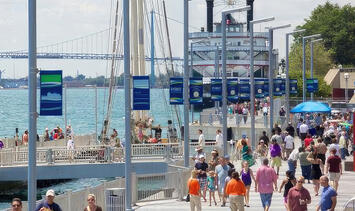
Were Rust Belt cities ever really attractive? Cool? Livable?
No.
Rust Belt cities weren’t built for beauty, they were built for enterprise. Sure, there was wonderful beauty incidentally built along the way, but usually never in the majestic or monumental ways you see in some East Coast cities. There’s plenty of understated natural beauty in many places, but little of the spectacular scenery (and great weather) found in Sun Belt or West Coast places. Rust Belt cities were built principally as production centers, not commercial centers. However, once they lost the economic luster that brought millions of people to them, they emptied out as people sought economic opportunity and an improved quality of life elsewhere.
An emphasis on improving aesthetics could go a long way toward bringing them back.
I’m often reminded of this whenever I revisit Detroit, as I did last month. I noted this in the very first post of this blog back in 2012, Reasons Behind Detroit's Decline. One of the reasons I cited was Detroit’s lack of commitment to actual placemaking and aesthetics, during the period of its greatest growth. In fact, this was something noted in a prescient 1961 Time Magazine article that saw a city already past its peak:
“If ever a city stood as a symbol of the dynamic U.S. economy, it was Detroit. It was not pretty. It was, in fact, a combination of the grey and the garish: its downtown area was a warren of dingy, twisting streets; the used-car lots along Livernois Avenue raised an aurora of neon. But Detroit cared less about how it looked than about what it did—and it did plenty.”
Detroit’s inattention to aesthetics continued well beyond 1961. Several metros have since surpassed it in scale, but Detroit was one of the earliest developing sprawling metros. Excessively wide arterial streets, an over-engineered landscape because of a commitment to highway construction, an inability to establish a first-rate public transit system, and a post-1950 housing boom that focused on single-family home development within and beyond the city’s boundaries, all contributed to the city we see today.
At the same time Detroit’s sprawl exploded, the city leveled much of its pre-WWII housing stock. The housing types that would later appeal to 1970’s urban pioneers, 1980’s yuppies, and 1990’s/2000’s creative class types, serving as a catalyst for revitalization, ended up being the wide expanses of urban prairie Detroit became known for. If you wonder why some cities that suffered economic decline didn’t fall as far as Detroit did, that’s one explanation.
I’ll note here that I toured downtown Detroit and nearby neighborhoods extensively last month, for the first time in about five years. I came away quite impressed by the ongoing work in the city. I stayed at the Westin Book Cadillac hotel, a 31-story neo-Renaissance that opened in 1924. The structure sat vacant for 22 years before reopening in 2008. The hotel is in the midst of a $20 million renovation now.
As for the rest of downtown and adjacent neighborhoods, I wrote about what I saw in a post last month. I’ll quote myself here:
"There were signs of renovation and new construction all around, reminiscent of Chicago’s Loop in the 2000’s. We ventured through much of downtown and tarps and scaffolding were everywhere. Heading northward into Midtown much more new construction is visible. You’ll see plenty of recently built and under construction five-over-ones along Woodward Avenue, as well as infill single family homes and townhouses on side streets....
Read the rest of this piece at Corner Side Yard Blog
Pete Saunders is a writer and researcher whose work focuses on urbanism and public policy. Pete has been the editor/publisher of the Corner Side Yard, an urbanist blog, since 2012. Pete is also an urban affairs contributor to Forbes Magazine's online platform. Pete's writings have been published widely in traditional and internet media outlets, including the feature article in the December 2018 issue of Planning Magazine. Pete has more than twenty years' experience in planning, economic development, and community development, with stops in the public, private and non-profit sectors. He lives in Chicago.












